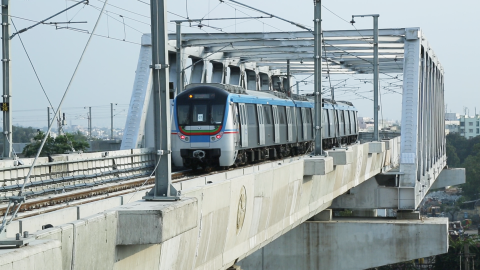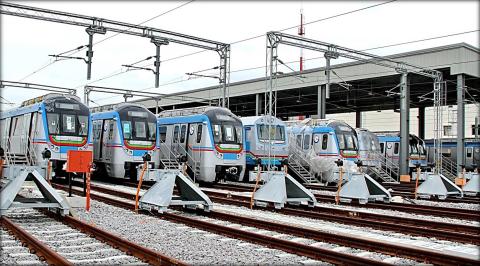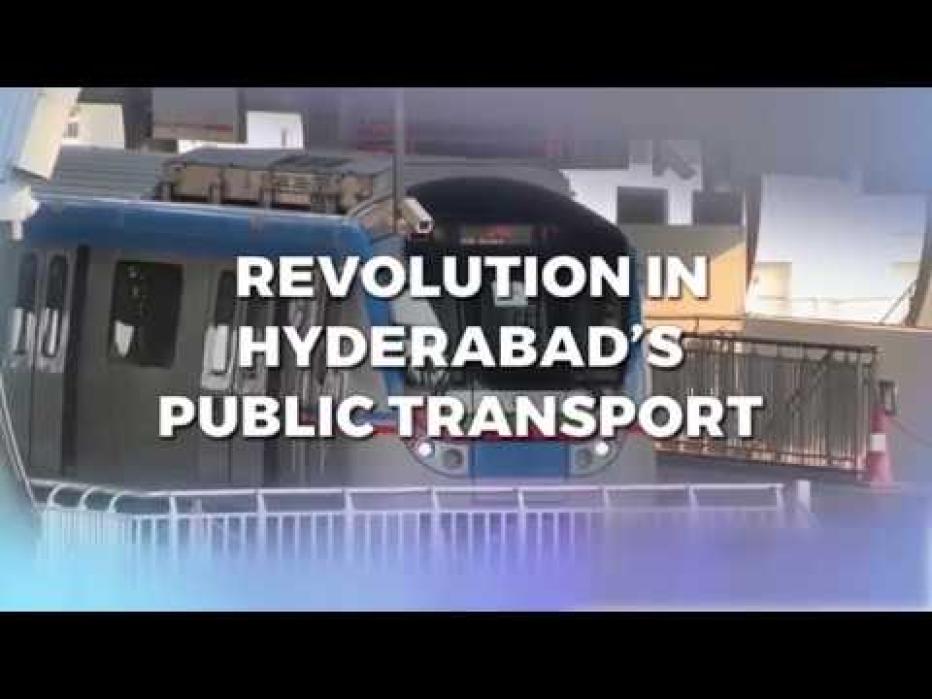
Hyderabad Metro Rail. Image courtesy of L&T Hyderabad Metro Rail Ltd
With a population of approximately 8.7 million people, Hyderabad in the Andhra Pradesh region in southern India is one of India’s largest and most densely populated cities. When the Government of Andhra Pradesh announced an ambitious project to transform the daily travel experience for millions of its residents, Jacobs was part of the team responsible for realizing this city-shaping project.
The Hyderabad Metro Rail project delivered a new 43 mile (69.2km) elevated high-capacity transport network, including 66 stations along three elevated corridors, for the people of Hyderabad.
Our engineers, along with our joint venture partners, delivered detailed design for the viaduct structures along one of three elevated rail corridors: an 18 mile (29km) stretch between Nagole and Raidurg. Our safety consulting team completed an independent safety assessment of the railway systems for the entire network.
With the final stage of development, which opened in February 2020, the project has transformed the daily commute experience for over 17,000 passengers.
-
43 miles
elevated rail network
-
400 K
passengers on average daily
-
5000 tonnes
reduction in carbon emissions
-
20 %
in cost savings realized
“It was a great experience to work on this massive urban transport project executed with the Public Private Partnership (PPP) model. Managing and coordinating the expectation of various stakeholders was the biggest opportunity. We achieved the project’s objective with meticulous resource planning, value engineering and by adhering to our delivery commitments.”
Transporting Hyderabad Toward a Better Future
The city of Hyderabad in southern India has a population of approximately 9 million and a population density of about 48,000 persons per square mile, making it the fourth most populous city in India.
In 2003, with stifling congestion, high levels of air pollution, and a fast-growing population and suburban rail transit system struggling to keep up with demand, the Government of Andhra Pradesh announced it would deliver a new high-capacity, elevated metro transport system for Hyderabad. In doing so, it aimed to transform the daily travel experience for millions of its residents, improving mobility, enhancing their way of life and supporting future population and economic growth.
Work on the Hyderabad Metro Rail (HMR) commenced in 2011. The network, which officially opened in February 2020, runs a total distance of 43 miles (69.2 kilometers) through 66 stations along three high density corridors, making it the second longest elevated rail system in India.
Our engineers, alongside our joint venture partners, helped deliver this nation-building endeavor, providing detailed design services for the viaduct structures along a 29km stretch of Corridor 3 from Nagole to Raidurg stations. The team also delivered independent safety assessments of the railway systems for all three corridors.
The ambitious project is an amalgamation of numerous engineering feats, an eco-friendly design and an unwavering focus on improving accessibility for all residents.
-
Hyderabad Metro Rail - passengers waiting at station. © L&T Hyderabad Metro Rail Ltd
-

Hyderabad Metro Rail - elevated rail line. © L&T Hyderabad Metro Rail Ltd
-

Hyderabad Metro Rail - rolling stock. © L&T Hyderabad Metro Rail Ltd
A test of foresight, precision and speed
While there were many complex challenges involved in this project, one that stood out in significance was the placement of substructure along the metro alignment, which passed through high density roads flanked by surrounding establishment. The project team worked closely with stakeholders to understand their requirements and incorporated various innovative options in the design of structures while adhering to overall project objective and schedule.
Compounding the level of difficulty, out-of-date utility maps for the location of proposed structures resulted in progressive revisions to the design during the execution stage. Site validation, placement of substructures and laying the foundations were critical tasks demanding precision and speed.
To achieve the rail alignment with these constraints, the team explored various foundation designs by introducing cantilever piers, portal piers, eccentric foundations and hammer head piers suitable for the site conditions.
Essential Connected Mobility for All
Dubbed ‘My City, My Metro, My Pride’, HMR’s slogan reflects its focus on delivering a people-centric development that improves the commuting experience for its citizens by providing a safer, efficient and integrated mode of public transportation.
Accessibility and first-mile/last-mile connectivity was key to providing an integrated transport network and end-to-end access to multiple modes of transportation, including skywalks, bicycle lanes and pedestrian infrastructure.
HMR connects to existing rail terminals, suburban stations and bus depots, providing links into commercial and office zones, schools, hospitals, leisure and retail destinations. Commuters can enjoy the ease of travel into highly congested areas of Hitec City, Gachibowli, Jubilee Hills and other populous areas with the comfort of air-conditioned metro coaches. The coaches themselves cater to the requirements of all commuters, including differently-abled and elderly passengers.
Cutting-edge Technology Delivers Greater Sustainability
Eco-friendly and fully automated, HMR deploys state-of-the-art rolling stock to reduce its carbon footprints. Regenerative Braking Technology (RBT) and Communication Based Train Control (CBTC) technology to enhance safety and increase the frequency of trains.
Combined with clever landscaping—which includes the planting of thousands of trees around the rail depots to improve the cityscape—the new mode of transport is expected to eliminate tens of thousand tons of CO2 from the environment. The innovative rolling stock regenerates energy during electro dynamic braking and will help reduce Hyderabad’s carbon emissions.
A Clear Focus on Value
Operated by Hyderabad Metro Rail Limited, HMR is the world’s largest Public-Private Partnerships (PPP) metro project ever conceived. Value Engineering (VE) was an essential part of a Design-Build contract and we supported the stakeholders in achieving this objective successfully.
The team conducted rigorous studies of superstructure and sub-structure designs, conceptualized design options and carried out numerous workshops with stakeholders to identify cost-savings opportunities that resulted in optimal design outcomes. Our work translated to numerous benefits to the project including design enhancements, time savings and reduced financial risks that led to significant cost savings of at least 20 percent compared to the original concept design.

Revolution in Hyderabad’s Public Transport
Award winning excellence
Nine years after its inception, HMR emerged as one of the most successful PPP projects in the metro sector, and one that has helped Hyderabad transform into a competitive Indian city that is modern, people-friendly and green.
HMR has garnered numerous national and global accolades, including:
- Best Urban Mass Transit Project 2018, Government of India
- Concrete Excellence Award 2018, Indian Concrete Institute
- Platinum Award for Hyderabad Metro stations: Rasoolpura, Paradise and Prakash, Indian Green Building Council
- Best Upcoming Metro Rail Project of the Year 2015 and 2017, Construction Week India
- Platinum Award for the Best Transportation Project in India 2016, Skoch
- Metro Rail Project of the Year – 2013, Construction Week India
- Global Engineering Project of the Year – 2013, Global Infrastructure Forum New York














































